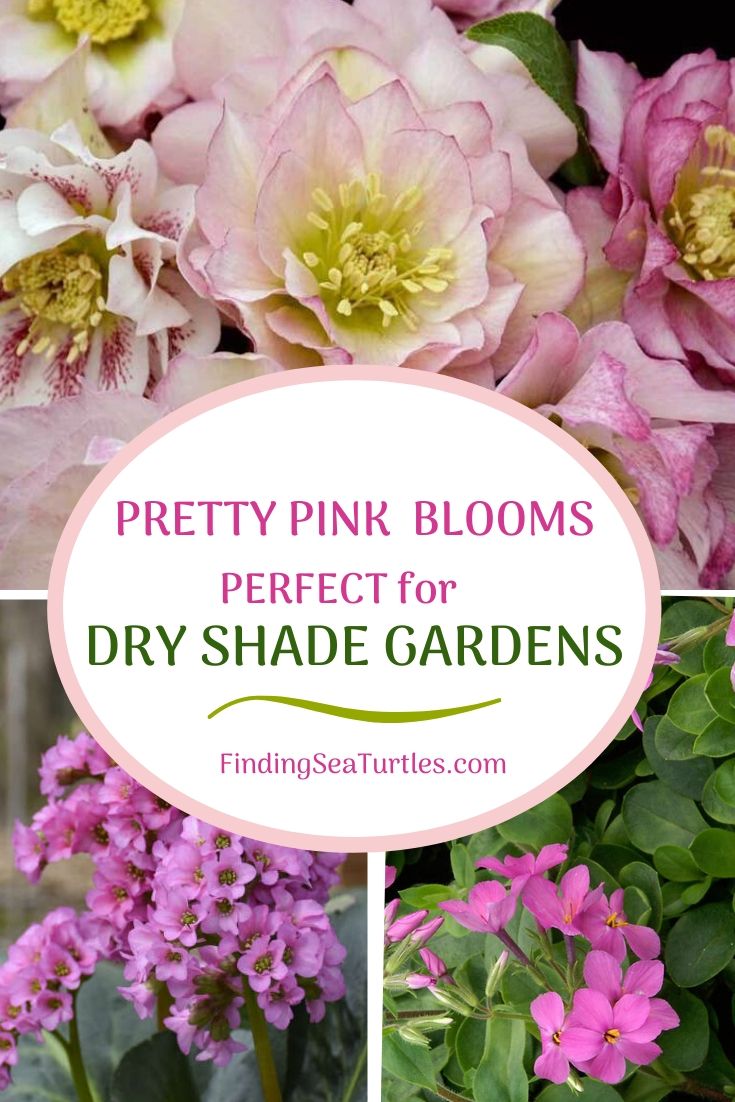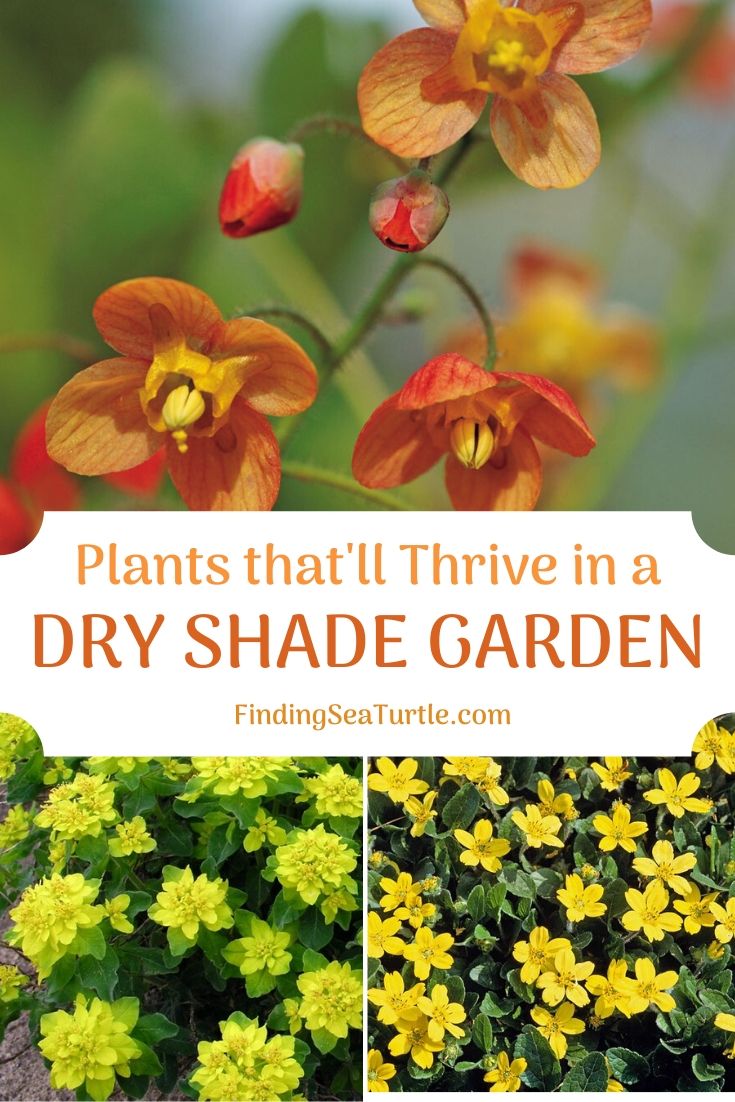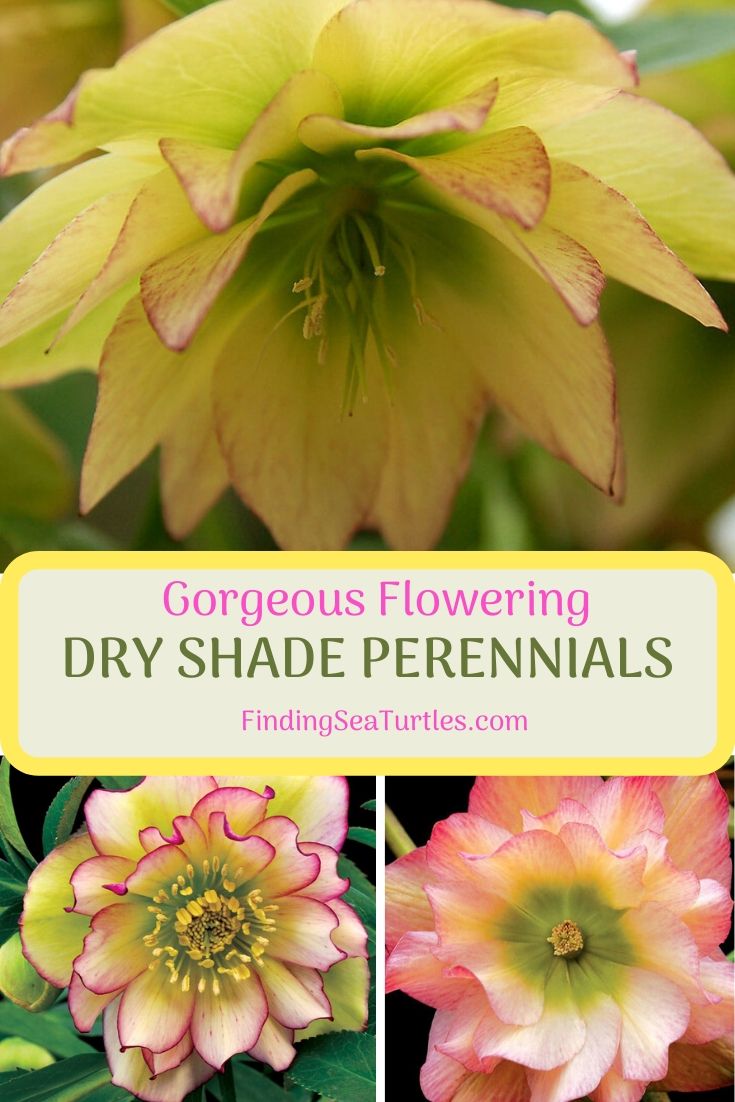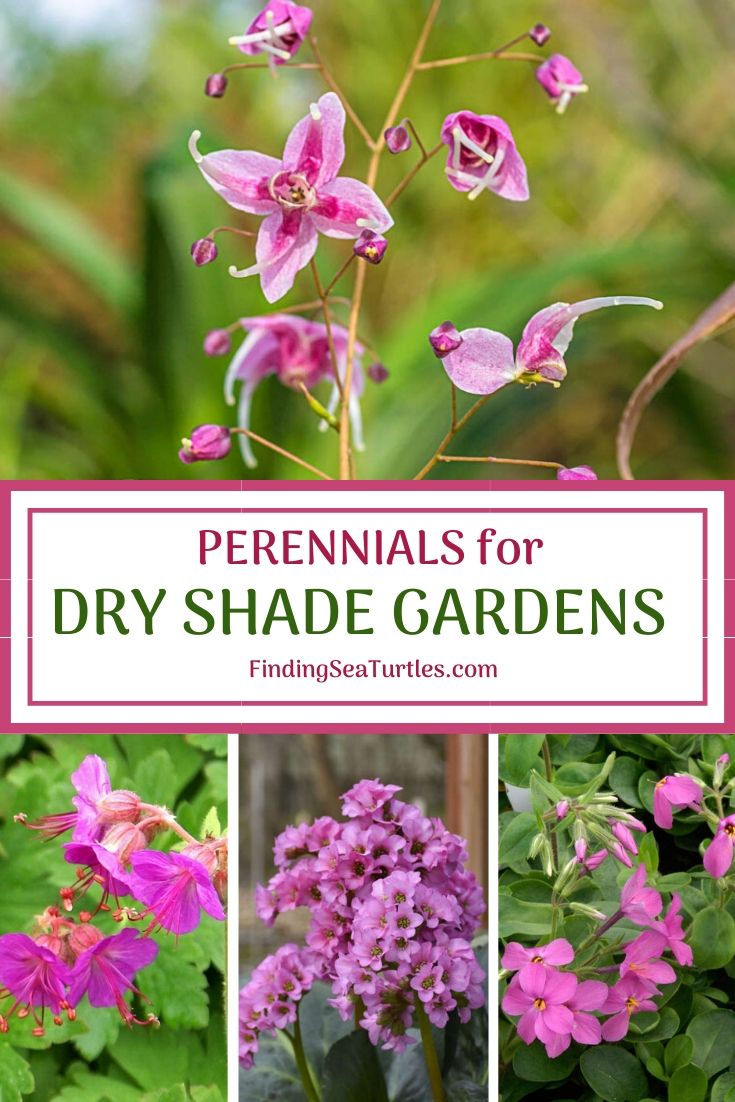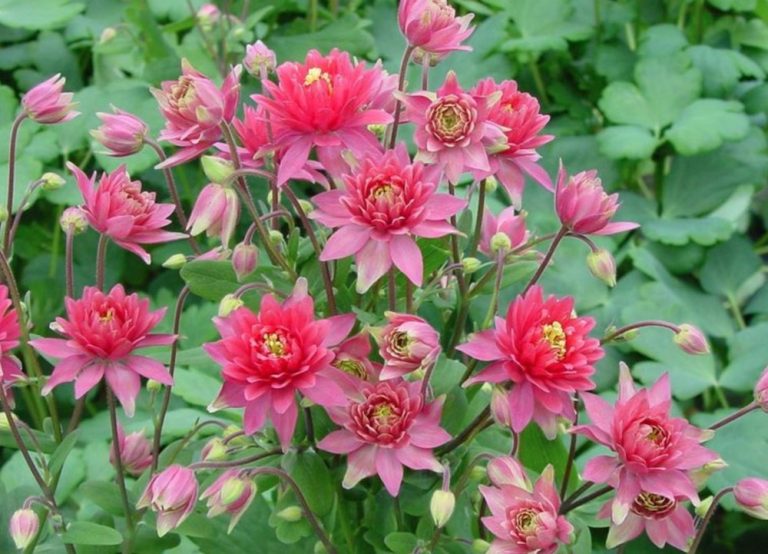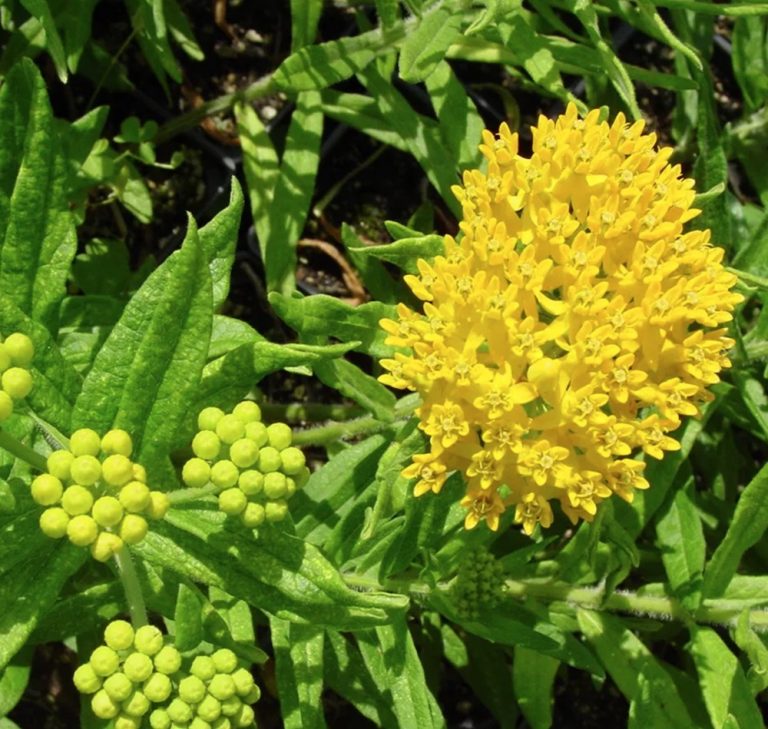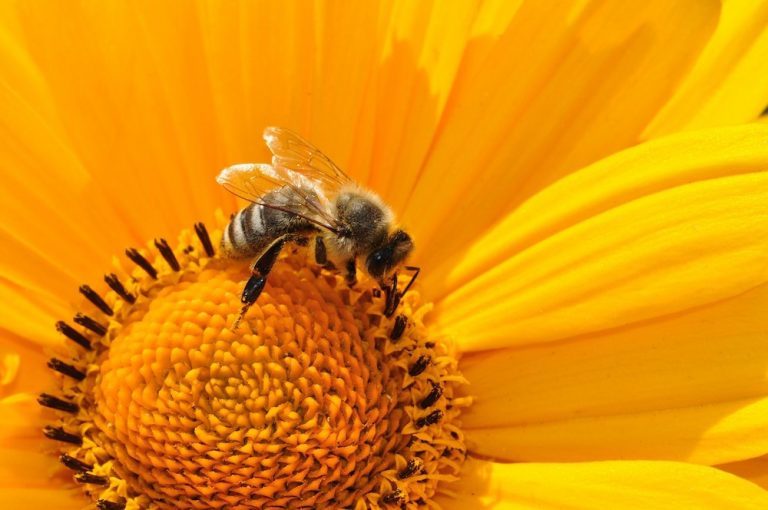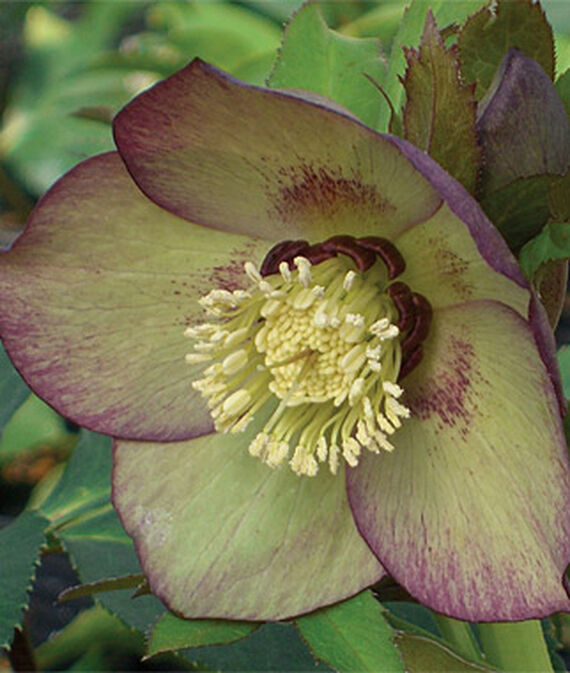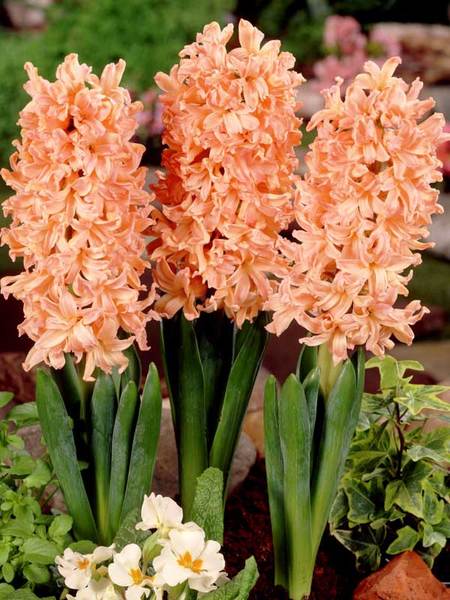Best Flowering Dry Shade Perennials
Flowering dry shade perennials grow and even thrive in garden conditions with limited rainfall and sunlight. Frustrated with areas of your garden having bare spots? Areas where grass just doesn’t grow. Why not consider growing plants that don’t mind shade and do with less rainfall?
Our list of flowering dry shade perennials once established, thrive in deep shade areas that receive little rainfall. Garden areas where grass won’t grow are ideal spaces for dry shade plants. These unsightly garden areas may remain bare with maybe a couple of scattered weeds growing. We all have these problematic garden areas in our yards. These bare spots may be under the eaves of the home where gutter water is redirected away from the home’s foundation. Or in the areas underneath the tree canopy. Trees also create a similar situation in that tree roots drink up quite a bit of water leaving less and less water for the surrounding plants. Most plants suffer in garden areas that receive little water. However, planting the right type of plants in the right type of garden environment can improve the plant’s chances of survival.
We rounded up a few dry shade plants that are known to settle into a dry shade environment. All the while adding color and interest to these barren garden areas. Plant the right plants in the right places. No different than using the right tools for the right DIY projects.
Take a look at these flowering dry shade perennials for dry shade gardens. And be sure to let us know what you think.
-
Brunnera – Flowering Dry Shade Perennials
Brunnera is ideal for a woodland setting. It naturalizes along the garden. Brunnera is also known as Siberian Bugloss and False Forget Me Not.
Sterling Silver Brunnera
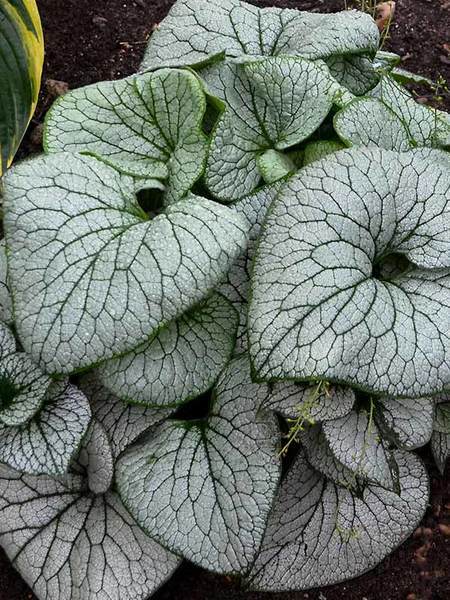
Sterling Silver Brunnera‘s leaves offer a dynamic texture and color. Silvered leaves etched with emerald green veining. Grows in zones 3 to 8 in mostly Sunny to mostly shady gardens. Reaches 10 to 14 inches tall. Blue flowers appear from mid to late Spring. Tolerates normal, sandy, or clay soil conditions. Resistant to deer. Tolerant of shade, wet site, and dry shade conditions. And can be planted in containers.
Jack of Diamonds Brunnera
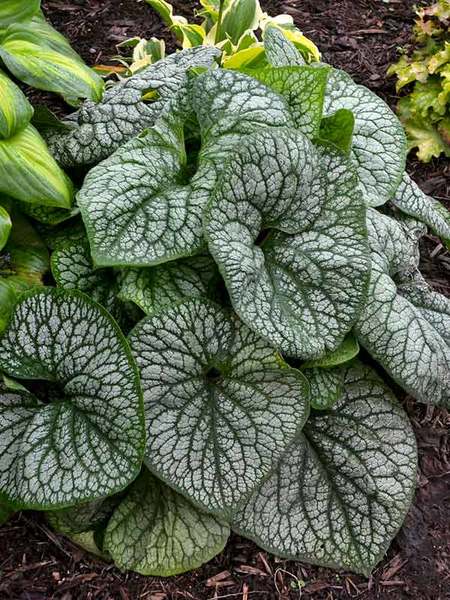
Heart shaped foliage of the Jack of Diamonds is heavily silvered with dark green veins. Flowers are baby blue color similar to forget-me-not blooms. Grows in zones 3 to 8 in mostly Sunny to mostly shady gardens. Reaches 16 inches tall. These lovely blue flowers appear from mid to late Spring. Tolerates normal, sandy, or clay soil conditions. Resistant to deer and is tolerant of shade, wet site, and dry shade conditions. And lastly, Jack of Diamonds can be planted in containers.
Alexander’s Great Brunnera
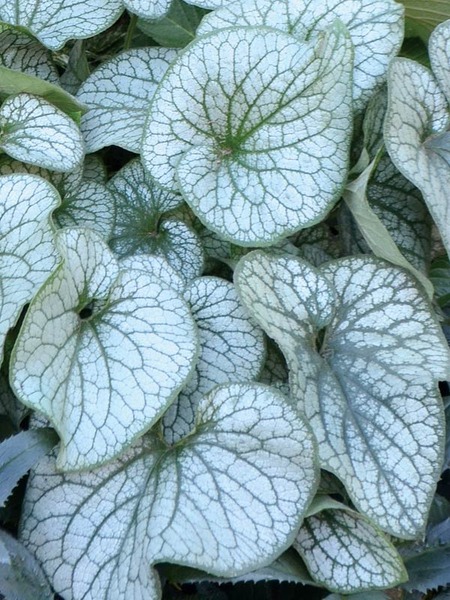
Large heart-shaped leaves that are heavily silvered appear on Alexander’s Great Brunnera. With sprays of sky blue flowers appear over this lush foliage. Grows in zones 4 to 8 in mostly Sunny to mostly shady gardens. Reaches 14 inches tall. Beautiful blue flowers appear from early through late Spring. Tolerates normal, sandy, or clay soil conditions. Resistant to deer and tolerant of shade, wet site, and dry shade conditions. And this Brunnera can be planted in containers.
2. Helleborus
Helleborus is referred to as the harbinger of spring. Many Helleborus bloom for six weeks in the late winter and early spring. Helleborus can also be used as an evergreen ground cover. These cup-shaped flowers are also known as Lenten Rose or Christmas Rose.
Dark and Handsome Helleborus
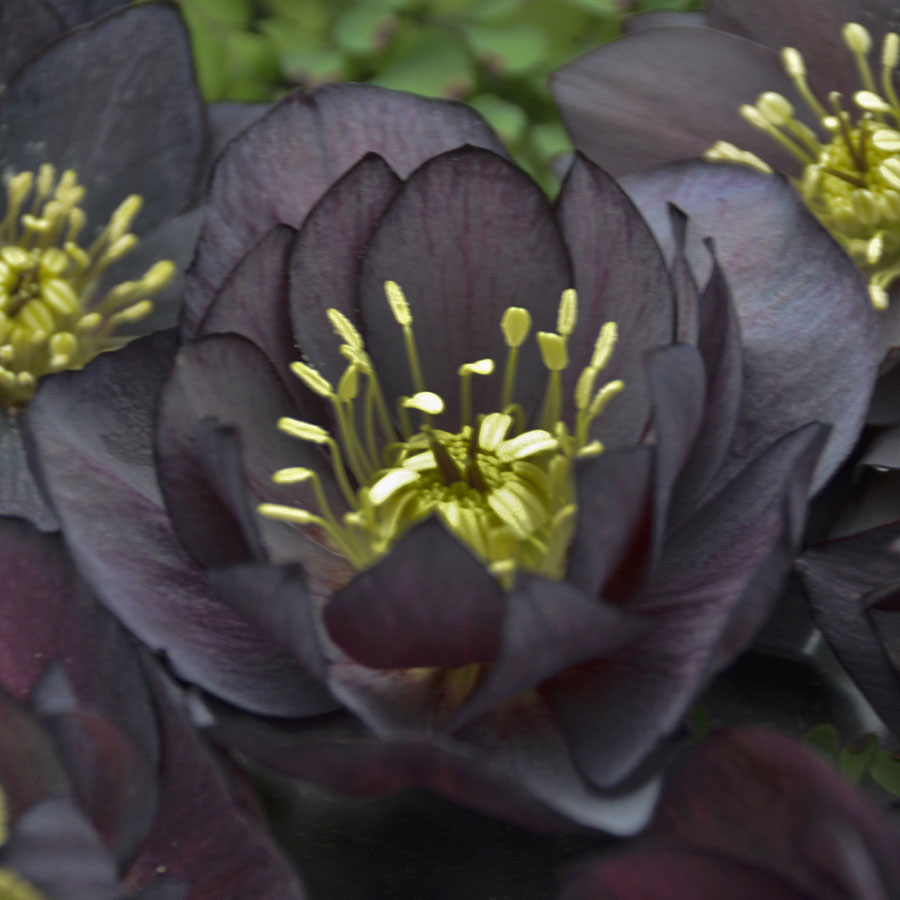
A gorgeous helleborus with dark purple, near black double blooms with dark evergreen foliage. Dark and Handsome grows in zones 4 to 9 in full shade to part shade and part Sun. Reaches 18 to 24 inches tall and wide. Dark purple blooms appear in early through late Spring. The foliage is dark green and medium green. Resistant to deer and pests. Drought tolerant perennial once established. And best of all, Dark and Handsome provides Winter interest to the garden.
Amber Gem Helleborus
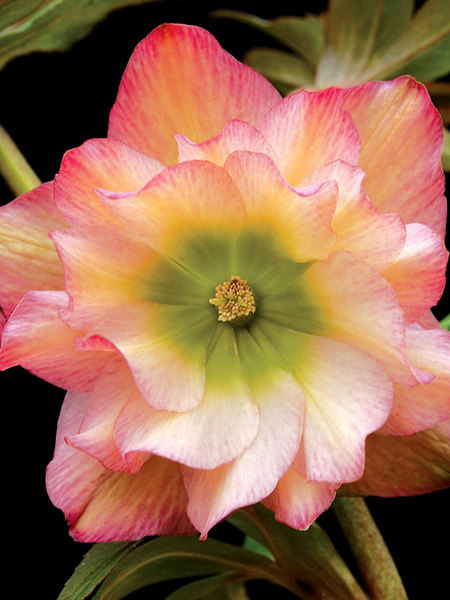
Blooms are soft yellow ruffled petals with stenciled red edges. Amber Gem grows in zones 5 to 8 in full shade to mostly Sunny. Reaches 12 inches tall. Blooms are yellow with red that appear early through late Spring. Tolerates normal, acidic, or sandy soil conditions. Resistant to rabbits and deer. Tolerant of shade and dry shade conditions. And Amber Gem provides Winter interest to the garden.
Flower Girl Helleborus
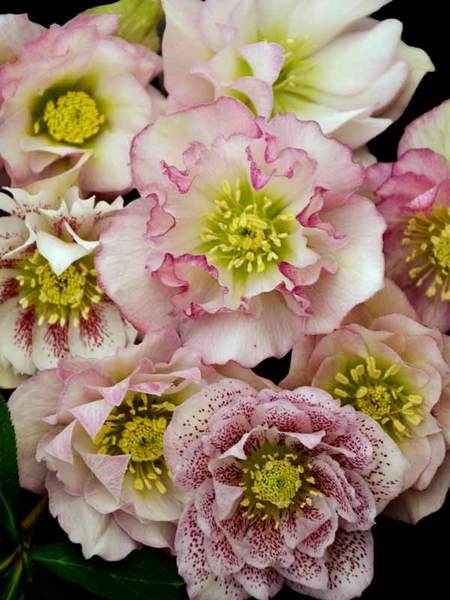
Flowers are vanilla blushed, light pink to maroon tinted. The Flower Girl Helleborus has ruffled petals that surround ivory stamens. Grows in zones 4 to 9 in full shade to mostly Sunny. Reaches 18 to 24 inches tall. White with pink blooms appear early through late Spring. Tolerates normal, acidic, or sandy soil conditions. Resistant to rabbits and deer. Tolerant of shade and dry shade conditions. Provides Winter interest to the garden. A very special Hellebore developed by Hans Hansen.
True Love Helleborus
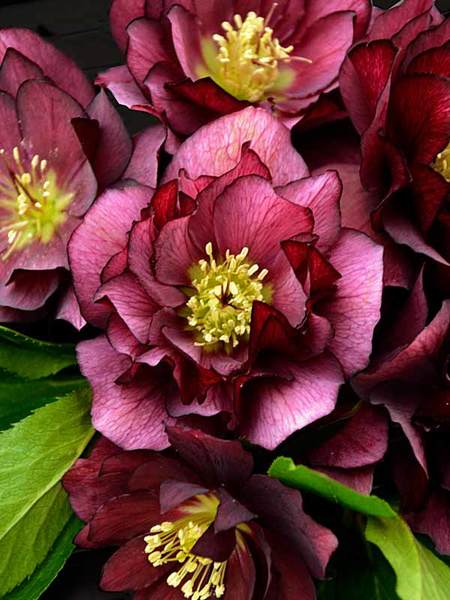
Shades of rich wine, outlined with darker margins and glowing golden centers appear on the True Love Helleborus. Grows in zones 4 to 9 in full shade to mostly Sunny. Reaches 18 to 24 inches tall. Burgundy blooms appear early through late Spring. Tolerates normal, acidic, and sandy soil conditions. Resistant to rabbits and deer. Tolerant of shade and dry shade conditions. Provides Winter interest to the garden. Another beauty developed by Hans Hansen.
3. Poscharskyana Campanula
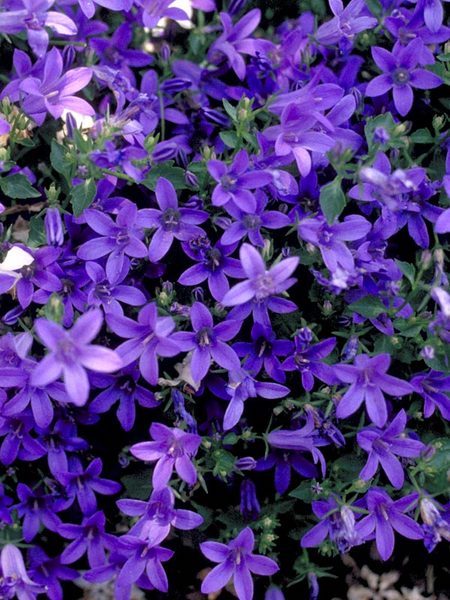
Starry blue flowers appear in early Summer. Poscharskyana Campanula is also known as Serbian Bellflower and Bellflower. Grows in zones 3 to 8 in mostly shade to full Sun. Reaches 6 inches tall. Blue blooms from early to late Summer. Beneficial for Pollinators. Tolerates clay soil conditions. Stands up to foot traffic as well as tolerant of shade, dry shade, and seaside salt conditions. And is ideal for rock gardens.
4. Epimedium – Flowering Dry Shade Perennials
Epimedium is also known as Barrenwort and Bishops Hat. Establish epimediums in dry shade below shrubs and large perennials. Plant these as a substitute for mulch. They like neutral to acidic soil near Rhododendrons, Camellia, and Hosta. Epimediums thrive in dry conditions and don’t mind poor soils. Tolerant of drought conditions once established.
Pretty in Pink Epimedium
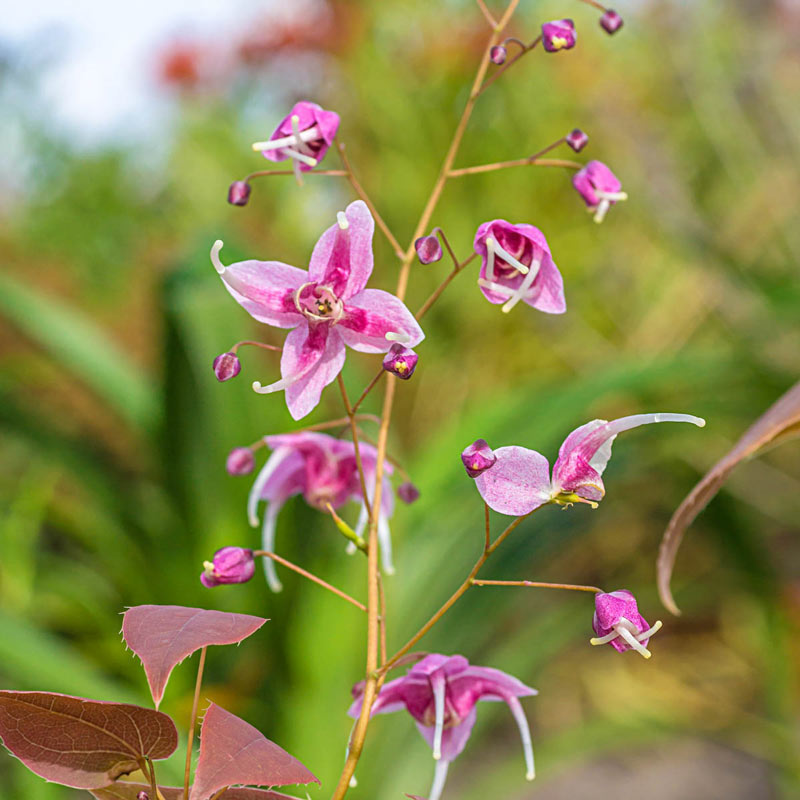
The patterned foliage is raspberry color with green. Pretty in Pink has blooms of shades of pink. Grows in zones 4 to 8 in full shade to part shade and part Sun. Reaches 12 to 18 inches tall with a spread of 24 to 36 inches wide. Blooms early through late Spring. Attracts butterflies and beneficial pollinators. Drought tolerant once established. Grow as a container plant or in a shade covered rock garden.
Fairy Wings Epimedium
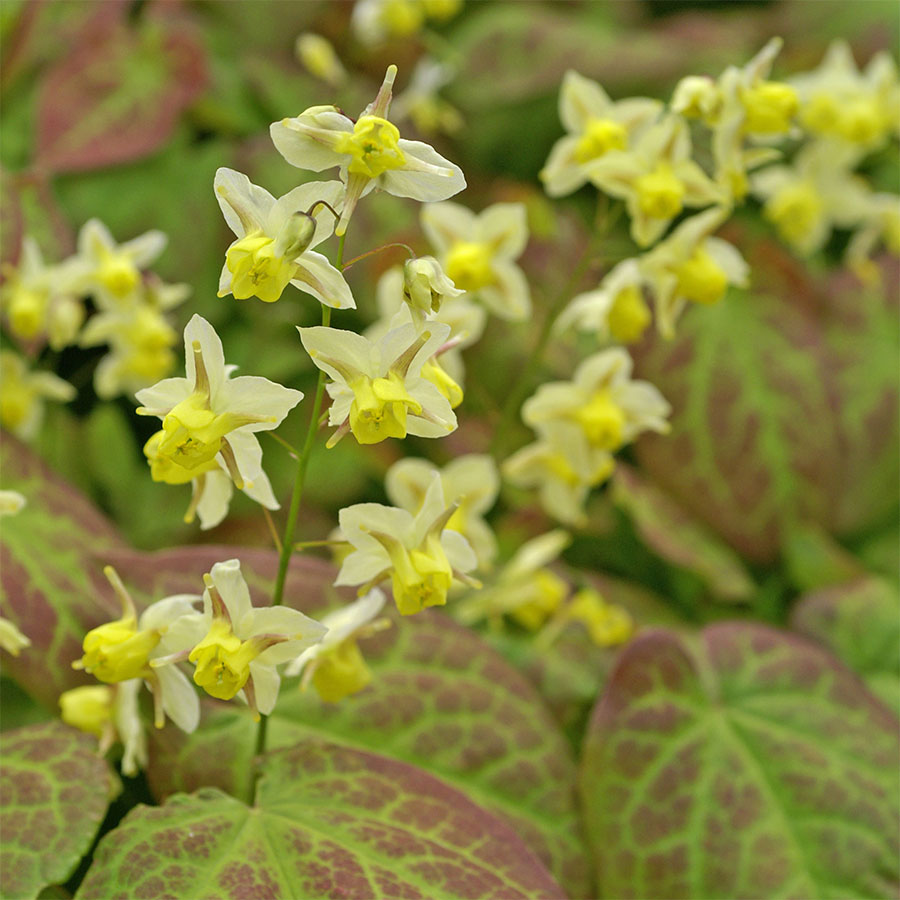
Heart-shaped foliage begins with a tinged bright red before turning to solid green. Fairy Wings Epimedium has yellow primrose flowers. Grows in zones 5 to 9 in full shade to part shade and part Sun. Reaches 9 to 12 inches tall and wide. Light yellow blooms appear in mid to late Spring. Plant in normal, poor, or sandy soil conditions. Resistant to deer and is drought tolerant once established. An evergreen ground cover that stays lovely even during periods of drought.
Orange Queen Epimedium

Newer foliage is red-edged with tri colored flowers. Orange Queen Epimedium is also known as Fairy Wand. Orange Queen can be used as a substitute for mulch. Single flowers are rich colors of orange, yellow, and red. Each flowering stem has 5 to 9 flowers. Grows in zones 4 to 9 in full shade to part shade and part Sun. Reaches 8 to 10 inches tall with a spread of 12 to 16 inches wide. Light red, orange, and yellow blooms appear in mid to late Spring. Attracts butterflies and can be planted in normal, poor, or sandy soil conditions. Resistant to deer, disease, and pests. Tolerant of heat, humidity, and drought conditions once established.
5. Bergenia
Bergenia are prized for their foliage and flowers. Leaf structure is leathery and waxed which allows them to store water. Performs well even in difficult garden sites. Also known as Saxifrage, Winter Bergenia, and Pigsqueak. Plant alongside Hostas, Ferns, and Lamium.
Dragonfly Sakura Bergenia
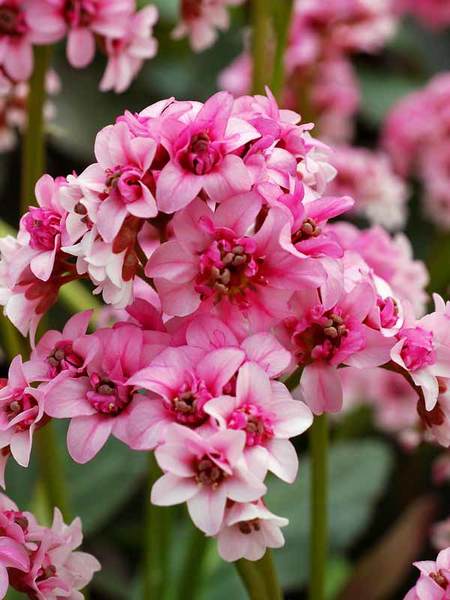
Large foliage that is a thick waxy green that transforms into deep plum tones over the Winter season. Flowers are rosy-pink clusters of semi-double blooms. Dragonfly Sakura Bergenia where Sakura is Japanese for Cherry Blossom. Dragonfly Sakura Bergenia grows in zones 4 to 9 in mostly shady to full Sun. Reaches 10 inches tall. Blooms early to mid Spring. Tolerates normal and clay soil conditions. Attracts butterflies and is resistant to deer and rabbits. And tolerant of dry shade, shade, and seaside salt conditions.
Magic Giant Bergenia
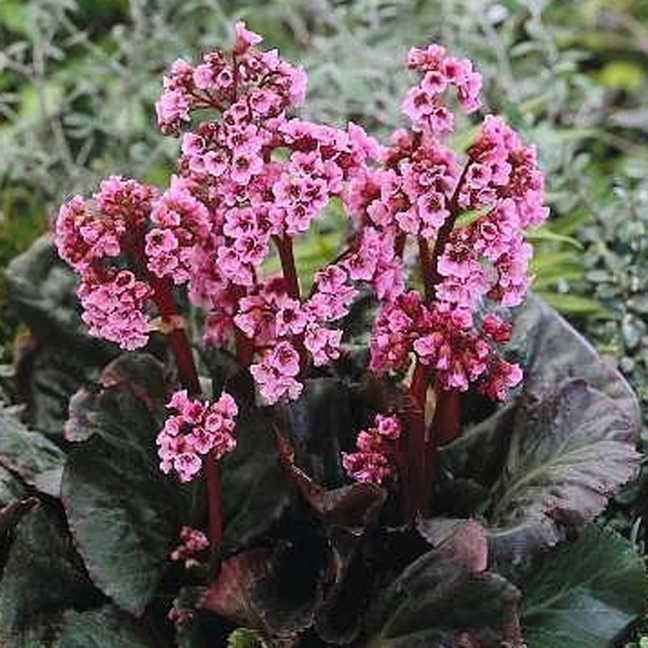
Magic Giant Bergenia has thick foliage that emerges a bronzy shade of green then darkens green over the Summer. Foliage turns to rich shades of burgundy over the Winter months. Magenta-red cup-shaped flowers appear over bright scarlet stems.
Grows in zones 3 to 8 in part shade and part Sun. Reaches 12 to 18 inches high and 18 to 24 inches wide. Blooms begin in mid Spring throughout the beginning of Summer. Resistant to deer, disease, and pests. Cold hardy perennial that tolerates drought conditions once established. Grow ‘Magic Giant’ with Hostas, Ferns, and Lamium. Tolerates poor, clay, and sandy soil conditions.
Winter Glow Bergenia
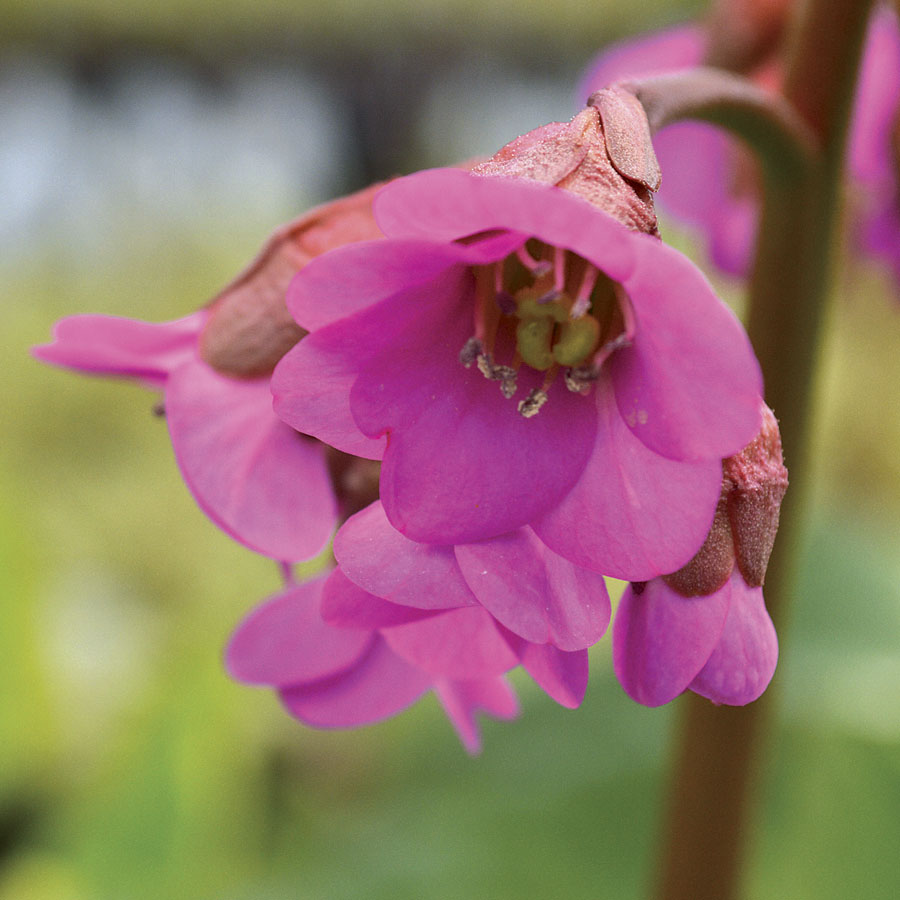
Blooms are dark pink, red, and rose colored that begin in early Spring and continue until early Fall. Winter Glow Bergenia has thick bright green foliage. However, the foliage will become glowing shades of bronze and scarlet. Grows in zones 3 to 8 in part shade and part Sun. Winter Glow is just 12 to 15 inches high and 12 inches wide. Resistant to deer and rabbits. Tolerant of dry shade and coastal garden conditions. Cold hardy perennial that tolerates drought conditions once established. Tolerates poor, clay, and sandy soil conditions. Adds Winter interest to the winter landscape. Flowers can be used in floral arrangements.
Miss Piggy Bergenia
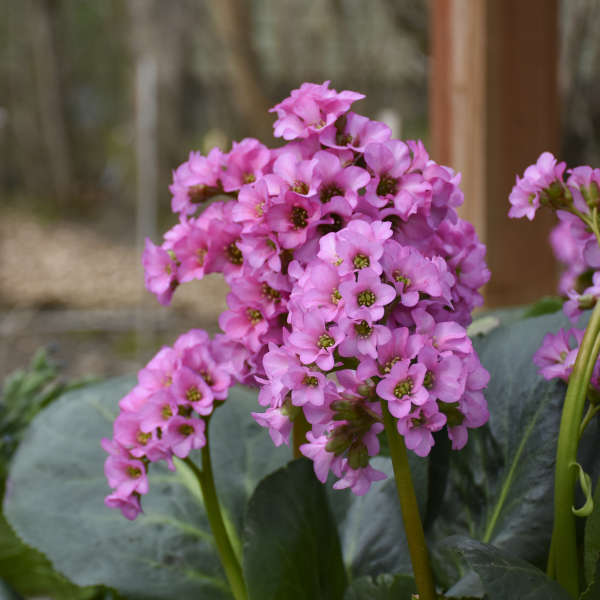
Also known as Heartleaf Bergenia and Pigsqueak. Foliage is thick dark green, glossy leaves. Miss Piggy Bergenia has bright pink flowers. Grows in zones 4 to 9 in full shade to full Sun. Reaches 16 to 18 inches tall with a spread of 28 to 32 inches wide. Pink flowers that bloom early through late Spring. Bee friendly and attracts butterflies. Resistant to deer and rabbits. Tolerant of dry shade, shade, and salt conditions.
6. Liriope – Flowering Dry Shade Perennials
Also known as Lilyturf and Monkey Grass. Liriope is the perfect solution for difficult sites. It thrives in a wide range of conditions from dry shade to full sun. And is an especially good selection for Gulf states with zones of 8, 9, and 10.
Big Blue Liriope
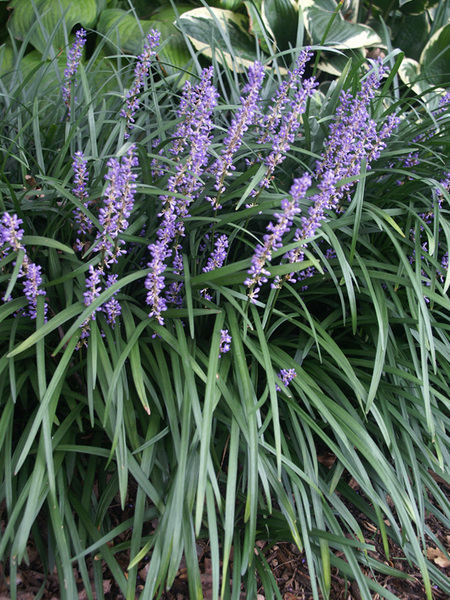
Floral spikes of blue appear above tufted arching, grass-like foliage. After blooming clusters of black berries follow. Big Blue Liriope grows in zone 5 to 10 in mostly shade to full Sun. Reaches 14 inches tall. Blue blooms appear from early through late Summer. Resistant to deer. Tolerates normal, acidic, sandy, or clay soil conditions. Tolerant of shade, dry shade, humidity, Seaside salt, and foot traffic conditions. Plant on a slope or bank. Thrives in a variety of conditions from dry shade to full Sun.
7. Euphorbia Polychroma
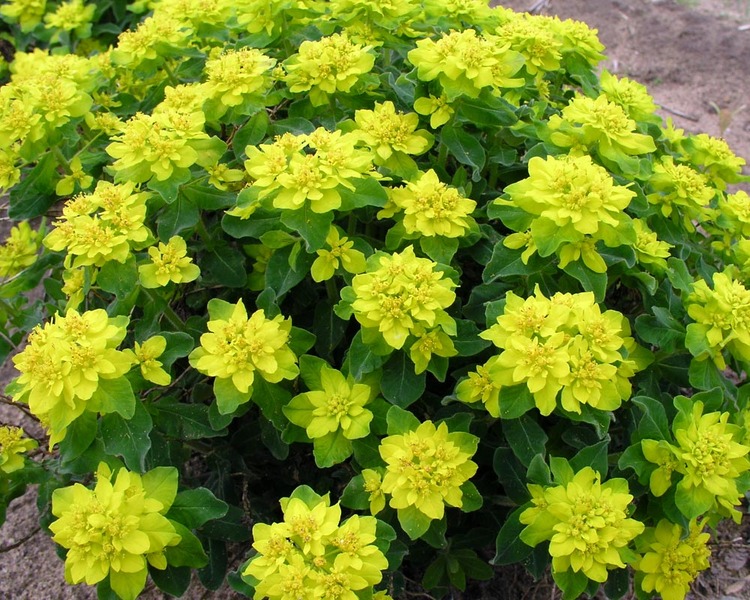
Flowers are a chrome-yellow in early Summer and turn red in the Fall. Euphorbia turns to a globe-shaped mound with attractive foliage. Also known as Cushion Spurge. Euphorbia Polychroma grows in zones 3 to 8 in full Sun to mostly sunny gardens. Reaches 14 inches tall. Yellow flowers appear from mid Spring to early Summer. Tolerates normal and sandy soil conditions. Attracts butterflies and is resistant to deer. Tolerant of hot dry site and dry shade conditions. Plant in containers. Use as a ground cover.
8. Phlox – Flowering Dry Shade Perennials
Phlox is an attractive woodland ground cover. Plant as a single specimen or in mass plantings for a stunning display of color. The plants grow out laterally along the ground, flowering in May on short erect stems with light green leaves. Select a location that is not always wet, or does not dry out completely and you will enjoy masses of carefree flowers. Fragrant blooms provide valuable early season nectar for swallowtail butterflies, day flying sphinx moths (hummingbird moths and clearwing moths) and hummingbirds. Woodland Phlox are an invaluable addition to any rock garden, foundation, or as an edger or ground cover.
Sherwood Purple Creeping Phlox

Blooms are soft lilac shades. Sherwood Purple Creeping Phlox is also known as Tufted Creeping Phlox. Grows in zones 3 to 8 in mostly shady to mostly Sunny. Reaches 12 inches tall. Purple blooms appear from mid to late Spring. Tolerates normal, acidic, or sandy soil conditions. Beneficial for Pollinators and attracts butterflies. Tolerant of shade and dry shade conditions. Plant in a rock garden, foundation, or ground cover.
Home Fires Phlox
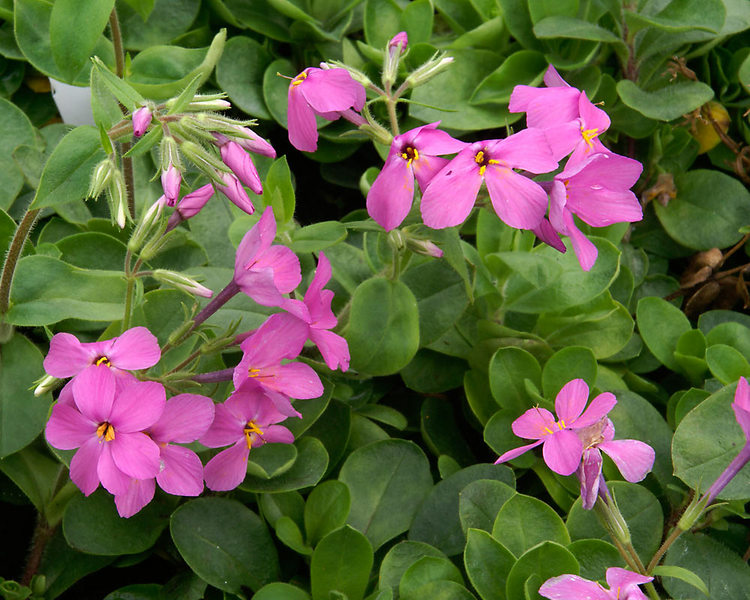
Masses of vibrant pink flowers appear on lush deep green narrow foliage. Home Fires Phlox are a fragrant phlox that spreads nicely. Grows in zones 3 to 8 in mostly shady to mostly Sunny. Reaches 12 inches tall. Fragrant pink blooms appear from late Spring to early Summer. Tolerates normal, acidic, or sandy soil conditions. Attracts butterflies and tolerant of wet sites, shade and dry shade conditions.
Louisiana Blue Phlox

Flowers are rich dark blue fragrant flowers. Louisiana Blue Phlox also known as Wild Sweet William and Woodland Phlox. Grows in zones 3 to 8 in mostly shady to mostly Sunny. Reaches 12 inches tall. Fragrant blue blooms appear from mid to late Spring. Tolerates normal or clay soil conditions. Attracts butterflies and tolerant of wet sites, shade and dry shade conditions. Plant in mass plantings for a stunning display. Semi-evergreen leaves turn burgundy in the Fall and Winter.
9. Chrysogonum virginianum Pierre
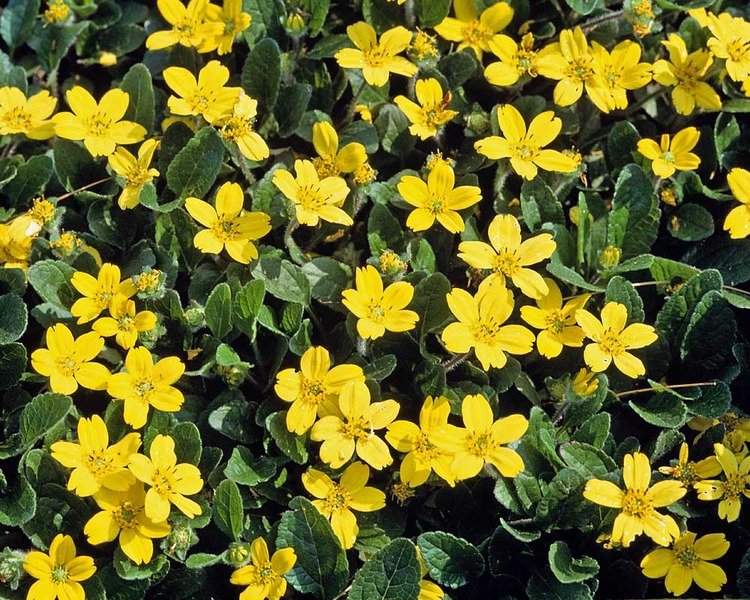
Foliage is soft green and covered with star-shaped golden flowers. Chrysogonum virginianum Pierre also known as Golden Star. Grows in zones 5 to 9 in full Sun to mostly shady gardens. Reaches 8 inches tall. Yellow flowers appear from late Spring to early Fall. Tolerant of shade, and dry shade conditions. Plant as a ground cover.
10. Lamiastrum
Lamiastrum spreads quickly. Growth can be kept compact under certain conditions. The Lamiastrum plant offers one of the easiest solutions to dry shade areas. Plant in containers. It is a good selection for the coldest regions as well as a good selection for the Gulf states.
Lamiastrum Galeobdolon
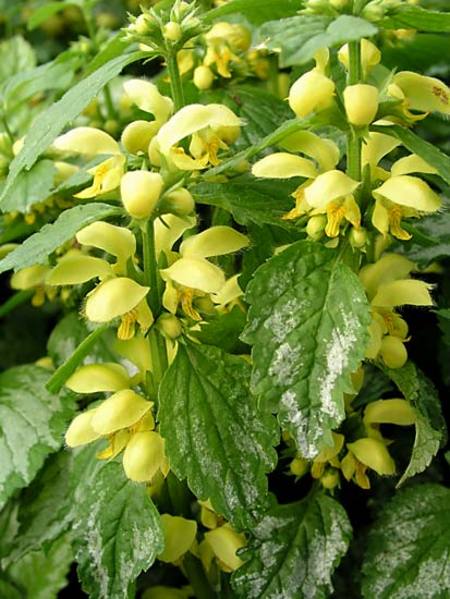
As Lamiastrum fills in, it forms a 12 inch high carpet of colorful foliage. Galeobdolon Lamiastrum is also known as Yellow Archangel. Flowers are tiered hooded, butter yellow with silver splashed bright green foliage. Grows in zones 3 to 8 in full Sun to full shade gardens. Reaches 12 to 15 inches tall. Yellow flowers appear from mid to late Spring. Tolerates normal or clay soils. Plant as ground cover ideal for a slope and banks. Resistant to rabbits and deer. Tolerant of humidity, shade, and dry shade conditions.
Herman’s Pride Lamiastrum
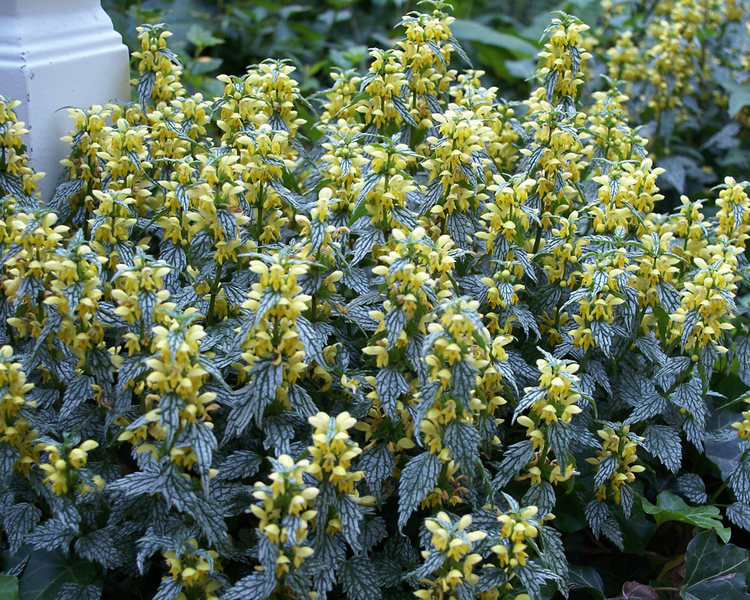
Foliage is metallic silver with green veins with flowers that are bright yellow. Herman’s Pride Lamiastrum is also known as Silver Archangel. Grows in zones 3 to 8 in full Sun to full shade gardens. Reaches 10 inches tall. Yellow flowers appear from mid to late Spring. Tolerates normal or clay soils. Plant as ground cover ideal for a slope and banks. Resistant to rabbits and deer. Tolerant of humidity, shade, and dry shade conditions. A good choice for a tough garden patch. Companion plants are Dicentra (Bleeding Hearts), Hosta, and Ferns.
11. Ajuga
Ajuga has lush waxy leaves with vibrant blooms. This plant spreads across the garden. Adapts to a variety of garden conditions with the exception of extremely wet garden areas. Ajuga is an evergreen ground cover in zones 6 to 9.
Genevensis Ajuga
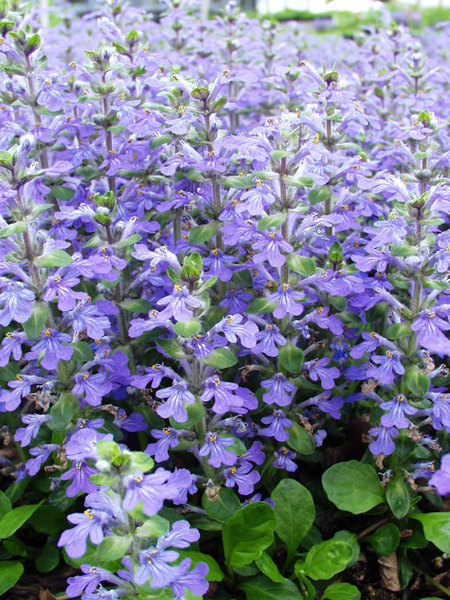
A hardy ground cover with mat-like green foliage. Genevensis Ajuga is also known as Carpet Bugle. Blue floral spikes pop up across the foliage. Grows in zones 3 to 9 in full Sun to full shade gardens. Reaches 3 inches tall. Blue flowers appear from late Spring to early Summer. Tolerates normal, acidic, or clay soils. Beneficial for Pollinators and attracts hummingbirds. Resistant to rabbits and deer. Plant along walkways or among stepping stones. Makes an excellent ground cover. Stands up to foot traffic. Tolerant of shade, dry shade, and seaside salt conditions.
Burgundy Glow Ajuga
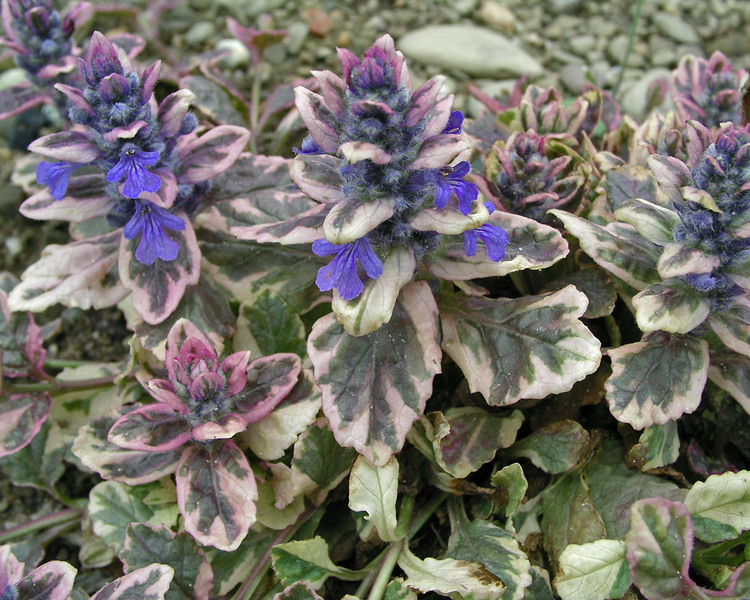
Tri-colored foliage of white, cream, and green that has burgundy-red tints. Blue floral spikes appear in late Spring. Burgundy Glow Ajuga grows in zones 3 to 9 in full Sun to full shade gardens. Reaches 3 inches tall. Blue flowers appear from late Spring to early Summer. Tolerates normal, acidic, and clay soils. Beneficial for Pollinators and attracts hummingbirds. Resistant to rabbits and deer. Plant as ground cover. Stands up to foot traffic and tolerant of shade, dry shade, and seaside salt conditions. A hardy ground cover that forms a dense carpet-like mat.
12. Geranium
Geranium also known as a perennial geranium. Forms a mounding habit that blooms from late Spring into the Summer.
Macrorrhizum Geranium
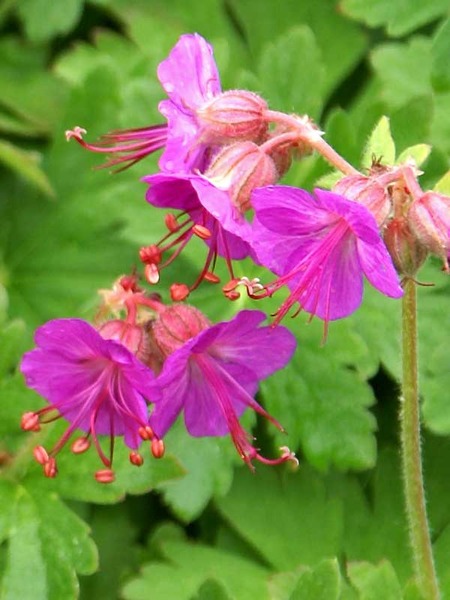
Flowers are thick clusters of five petaled pink. Apple scented foliage with a Fall display of red and bronze foliage tints. Clusters of crimson-red berry-like seed heads appear once the flower petals have dropped. Macrorrhizum Geranium is also known as Cranesbill and Perennial Geranium. Grows in zones 4 to 8 in full Sun to mostly shady gardens. Reaches 8 inches tall. Fragrant pink flowers appear from late Spring to early Summer. Tolerates normal, acidic, sandy, or clay soils. Beneficial for pollinators and attracts butterflies. Resistant to deer. Plant as ground cover. Tolerant of shade and dry shade conditions.
Biokovo Geranium
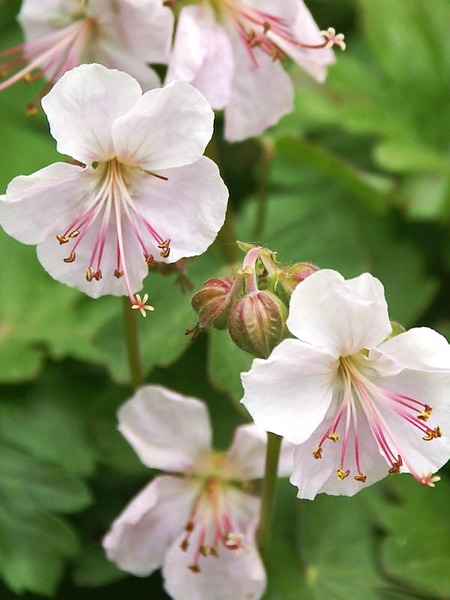
Biokovo Geranium is a native of the Biokovo Mountains in Europe. It displays masses of pink centered white flowers beginning late Spring. Fragrant foliage turns red over the Fall season. Grows in zone 5 to 8 in mostly shady to full Sun. Reaches 6 to 12 inches tall. Blooms late Spring to early Summer. Tolerates normal, acidic, or sandy soil conditions. Beneficial for Pollinators. Attracts butterflies and is resistant to deer. Tolerant of shade and dry shade conditions. Plant on a slope or bank as a ground cover. Use in container gardening. Provides Winter interest to the garden.
Biokovo Karmina Geranium
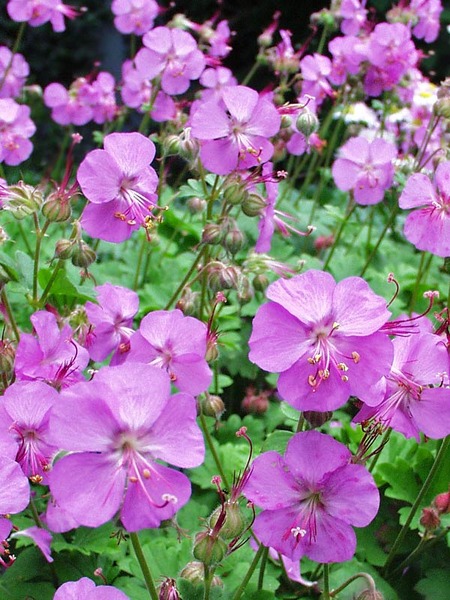
A great filler plant for the landscape. Masses of deep rose blooms cover the foliage beginning in late Spring. Biokovo Karmina Geranium is a native from the European Biokovo Mountains. Grows in zones 5 to 8 in mostly shady to full Sun. Reaches 6 to 12 inches tall. Pink to deep rose colored blooms appear from Mid Spring to mid Summer. Tolerates normal, acidic, or sandy soil conditions. Beneficial for pollinators and attracts butterflies. Resistant to deer and tolerant of shade and dry shade conditions. Plant on a slope or bank as a ground cover. Use in container gardening. Provides Winter interest to the garden.
13. Lamium
Lamium is a good ground cover with attractive foliage. And a good selection for the coldest regions. Once established they can tolerate somewhat drier conditions. Lamium also known as Spotted Dead Nettle.
White Nancy Lamium
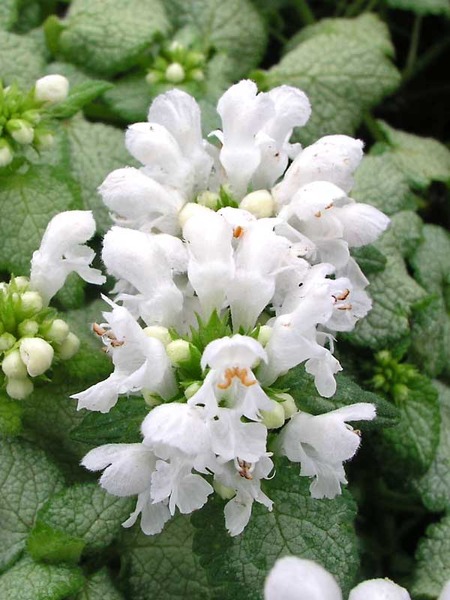
Flowers are small hooded, milky white clusters beginning in late Spring. White Nancy Lamium has silvery leaves with narrow green margins. Grows in zones 3 to 8 in full shade to mostly sunny. Reaches 6 inches tall. Blooms late Spring to early Summer. Tolerates normal or clay soil conditions. Plant on a slope or bank as a ground cover. Resistant to rabbits and deer. Tolerant of shade and dry shade conditions. A good choice for an all-white garden.
Orchid Frost Lamium
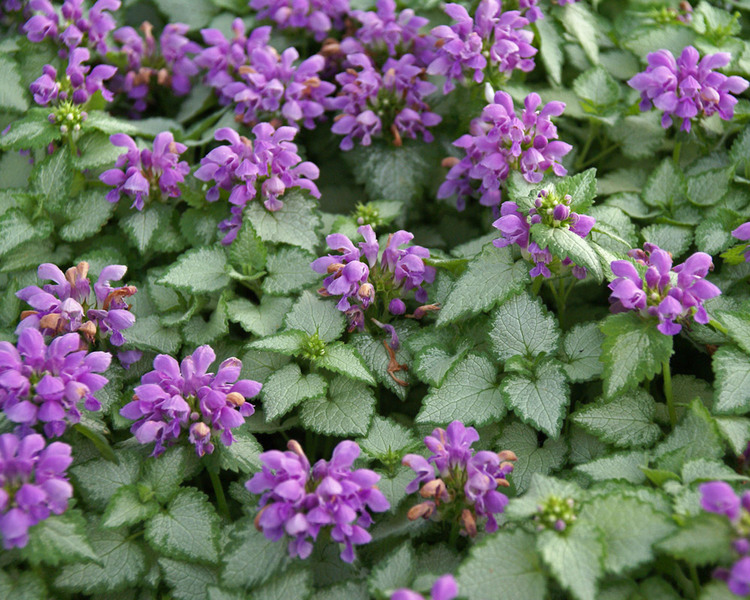
Flowers are hooded, soft orchid color. Foliage is silver with narrow green margins. Orchid Frost Lamium is a striking ground cover. Grows in zones 3 to 8 in full shade to mostly sunny. Reaches 8 inches tall. Lavender blooms late Spring to early Summer. Tolerates normal or clay soil conditions. Plant on a slope or bank as a ground cover. Resistant to rabbits and deer. Tolerant of shade and dry shade conditions. Plant alongside Hostas and Ferns.
Aureum Lamium
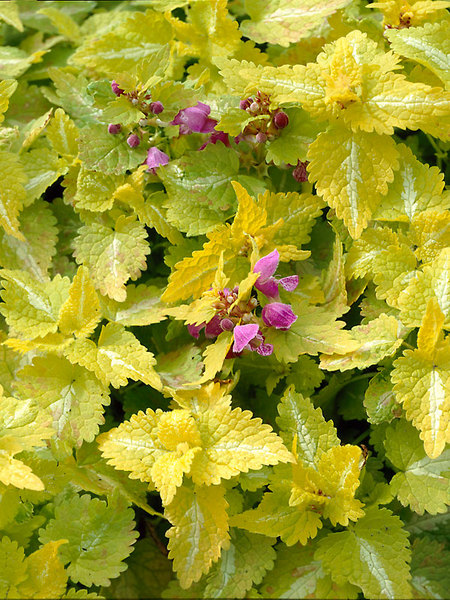
Blooms are rose purple with citrus yellow and a centered a white slash. Aureum Lamium will brighten a shady garden. Grows in zones 3 to 9 in full shade to mostly sunny. Reaches 6 to 8 inches tall. Rose with purple accent blooms late Spring to early Summer. Tolerates normal, sandy, or clay soil conditions. Plant on a slope or bank as a ground cover. Resistant to rabbits and deer. Tolerant of shade and dry shade conditions.
14. Heucherella
Heucherella are a cross between Heuchera and Tiarella. Their growth habit is a flowering mound. Heucherella has strong leaf colors with fantastic flowers. They excel in the northern regions as well as the heat and humidity of the Southern regions. Heucherella are also known as Foamy Bells.
Buttered Rum Heucherella
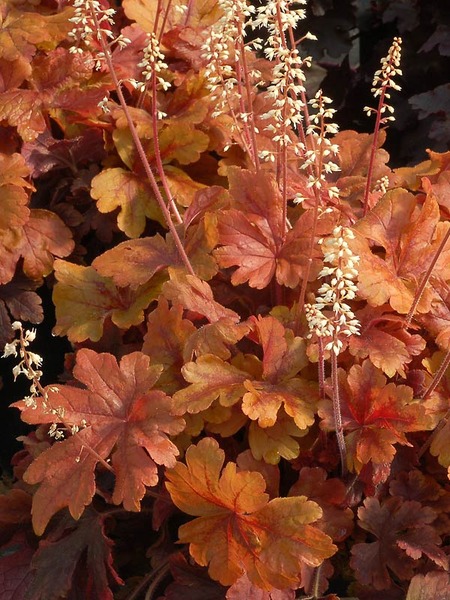
The warm coppery tones of Buttered Rum Heucherella provide year long appeal. Foliage are glossy, rounded maple leaves. As cooler weather appears, foliage turns a rose red color. Grows in zones 4 to 9 in full shade to full Sun. Reaches 7 inches tall. White floral sprays bloom in late Spring to mid Summer. Attracts butterflies and hummingbirds. Tolerates normal, sandy, or clay soil conditions. Plant on a slope or bank as a ground cover. Resistant to rabbits and deer. Tolerant of humidity, shade and dry shade conditions. Thrives in the Northern regions as well as the high heat and humidity conditions of the Southern regions.
Onyx Heucherella
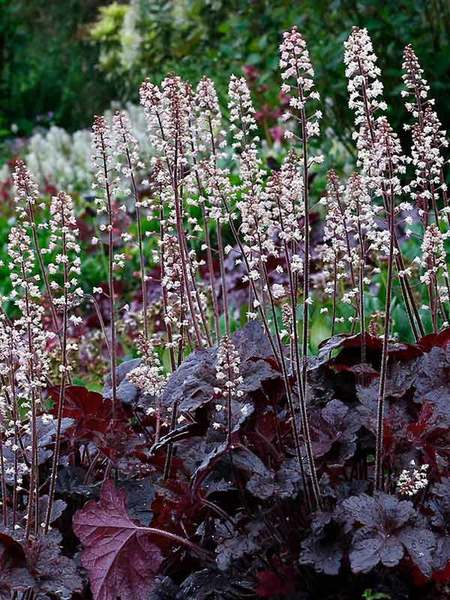
Foliage is glossy, chocolate-black with undersides of flash violet-red. Onyx Heucherella is a compact tidy plant. Grows in zones 4 to 9 in full shade to full Sun. Reaches 10 inches tall. Airy white blooms on dark stems open from pink buds in early to mid Summer. Attracts butterflies and hummingbirds. Tolerant of humidity, heat, and dry shade conditions.
Eye Spy Heucherella
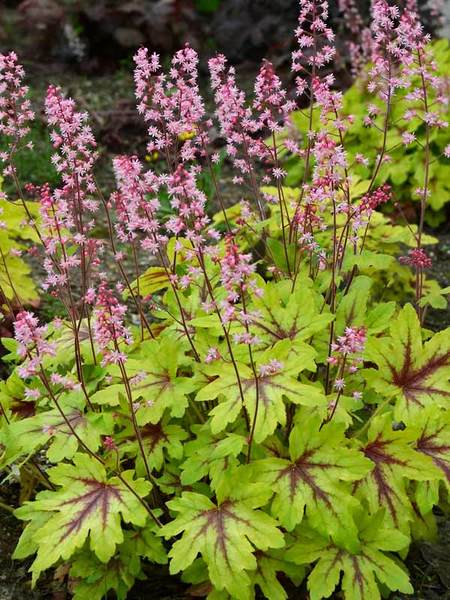
Amber-yellow foliage etched with deep rose veins becomes chartreuse green with a silver overlay. A compact plant, Eye Spy Heucherella has bubblegum-pink floral sprays. Grows in zones 4 to 9 in full shade to part shade and part Sun. Reaches 8 to 10 inches tall. Pink blooms late Spring to mid Summer. Attracts butterflies and hummingbirds. Tolerant of humidity and dry shade conditions.
These is our list of the best plants for a dry shade garden area. Useful and extremely tough plants that can brighten a dark shady garden area.
Dry shade plants can solve a variety of garden problems. From weed control to soil retention and provides a low maintenance garden. If you try any of these flowering dry shade perennials let us know how you make out.
Interested in gardening? If you found this helpful . . .
You May Also Enjoy some of our other gardening related posts.
16 Best Flowering Ground Covers for Shade
15 Best Flowering Ground Covers for Sun
12 Perennials That Butterflies Find Irresistible
And if you have any questions, feel free to reach out to us. We always are ready to help you out. Thank you for dropping by.
Mary


